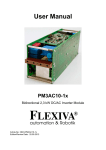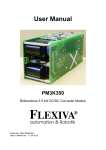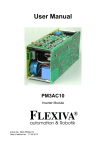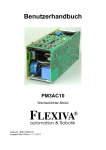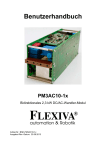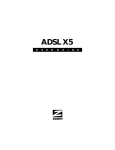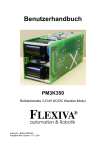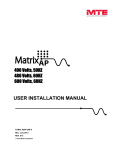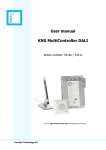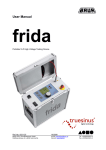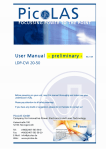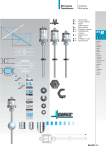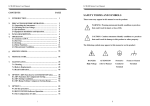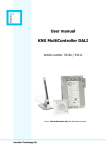Download User Manual - FLEXIVA automation & Robotik
Transcript
User Manual
PM3K350
Bidirectional 3.5 kW DC/DC Converter Module
Article No.: BNH-PM3K350-1x
Edition/Review date: 27.03.2015
User Manual DC/DC Module PM3K350-1x
Preface
Preface
The present Technical Documentation is to inform of the correct operation of the
DC/DC converter modules PM3K350. The modules serve to convert direct voltages in
a bidirectional way.
The operating manual is to be preserved.
It is prohibited to copy or duplicate texts, plans, and tables or to make them
accessible to any third parties without our express consent.
We draw your attention to the fact that the Technical Documentation shall not be part
of an existing earlier agreement or promise or part of a legal relationship.
All and any obligations result from the purchase contract that also solely contains the
warranty determination. The contractual provisions shall not be affected by the
Technical Documentation.
The documentations of the suppliers used shall apply along with the present
documentation of the manufacturer.
In addition to the operating manual, all universally valid legal and other obligatory
regulations concerning the prevention of accidents and the environmental protection
are to be complied with and to be instructed.
2
Flexiva automation & Robotik GmbH
Weißbacher Straße 3
D – 09439 Amtsberg
Benutzerhandbuch DC/DC-Modul PM3Kxxx
Table of Contents
Table of Contents
1
Introduction............................................................................................................... 6
2
Identification ............................................................................................................. 7
2.1 Product Trademark and Type Designation ........................................................ 7
2.2 Product Version / Version of Software / Editing State........................................ 7
3
Product Description ................................................................................................. 8
3.1 General Information / Utilization as Directed...................................................... 8
3.2 Technical Information and Data ......................................................................... 9
3.3 Power Connectors ........................................................................................... 11
3.4 Signal Connectors ........................................................................................... 12
3.5 Basic Structure and Function of the DC/DC Module........................................ 14
3.6 Safety Information............................................................................................ 14
3.6.1 Safety Measures for the Installation....................................................... 14
3.6.2 Remaining Dangers and Risks .............................................................. 14
3.6.3 Qualification of the Operating Staff ........................................................ 15
4
Preparation of the Product for the Use................................................................. 16
4.1 Transport ......................................................................................................... 16
4.2 Packaging ........................................................................................................ 16
4.3 Storing ............................................................................................................. 16
4.4 Commissioning ................................................................................................ 16
4.4.1 Connection of the DC Link..................................................................... 16
4.4.2 Connection of the Variable Voltage ....................................................... 16
4.4.3 Connection of the Power Supply ........................................................... 17
4.4.4 Connection of the Communication......................................................... 17
4.4.5 Putting the Module into Operation ......................................................... 17
5
Operation................................................................................................................. 18
5.1 Method of Functioning ..................................................................................... 18
5.1.1 Modes of Operation ............................................................................... 18
5.1.2 Parallel Connection of Modules at the Variable Voltage Side................ 19
5.1.3 Voltage Regulation of the DC Link......................................................... 20
5.1.4 Undervoltage / Overvoltage Regulator................................................... 21
5.1.5 Automatic Mode..................................................................................... 21
5.1.6 Virtual Capacitor .................................................................................... 22
5.1.7 Monitoring Functions / Shutdowns on Faults ......................................... 23
5.1.8 Empty DC Link....................................................................................... 25
5.2 Basic Parameterization .................................................................................... 25
5.2.1 Currents: variable voltage Side (VS side) .............................................. 25
5.2.2 Voltages: variable voltage side (VS side) .............................................. 26
5.2.3 Voltages: DC link (ZK Side) ................................................................... 28
5.2.4 Information............................................................................................. 30
5.2.5 Commands ............................................................................................ 31
5.2.6 Oscilloscope .......................................................................................... 32
5.3 Regulator Setting ............................................................................................. 35
5.3.1 Parameters of the VS-Regulator............................................................ 36
5.3.2 Parameters of the ZK-Regulator ............................................................ 36
5.4 Typical Cases of Application / Parameterization Examples ............................. 38
Flexiva automation & Robotik GmbH
Weißbacher Straße 3
D – 09439 Amtsberg
3
Benutzerhandbuch DC/DC-Modul PM3Kxxx
Table of Contents
5.5 Error Treatment ............................................................................................... 43
6
Programming / Parameterization........................................................................... 44
6.1 Preliminary Remarks ....................................................................................... 44
6.2 The ASCII Protocol used ................................................................................. 45
6.2.1 Read / write without checksum .............................................................. 45
6.2.2 Read / write with checksum ................................................................... 45
6.2.3 ASCII-long / ASCII-short........................................................................ 48
6.2.4 ASCII-short with checksum.................................................................... 49
6.2.5 Switching between the protocols ........................................................... 50
6.2.6 Concrete example.................................................................................. 51
6.2.7 Error messages during the communication ........................................... 53
6.3 Communication by Means of Terminal Software ............................................. 54
6.4 Communication by Means of ModuleConfigSuite ............................................ 54
7
The Parameterizing Software "ModuleConfigSuite"............................................ 55
7.1 Preliminary Remarks ....................................................................................... 55
7.2 Installation........................................................................................................ 55
7.3 Deinstallation ................................................................................................... 55
7.4 Software description ........................................................................................ 56
7.4.1 Overview................................................................................................ 56
7.4.2 Single-Mode / Multi-Mode...................................................................... 56
7.4.3 Groupings by Means of Colors / Backgrounds ...................................... 58
7.4.4 Meaning of the Error Codes................................................................... 59
7.4.5 Selection and Assignment of the Interfaces........................................... 59
7.4.6 Connecting / Disconnecting ................................................................... 60
7.4.7 Storing / Loading of Parameter Sets...................................................... 61
7.4.8 Reading-Out / Parameterization ............................................................ 61
7.4.9 Data Visualization / Recording............................................................... 62
7.4.10 Selecting of the Mode of Operation ....................................................... 64
8
Maintenance service and repairs by the customer service ................................ 65
9
Appendix ................................................................................................................. 66
4
Flexiva automation & Robotik GmbH
Weißbacher Straße 3
D – 09439 Amtsberg
Benutzerhandbuch DC/DC-Modul PM3Kxxx
Table of Figures
Table of Figures
Fig. 1:
Fig. 2:
Fig. 3:
Fig. 4:
Fig. 5:
Fig. 6:
Fig. 7:
Fig. 8:
Fig. 9:
Fig. 10:
Fig. 11:
Fig. 12:
Fig. 13:
Fig. 14:
Fig. 15:
Fig. 16:
Fig. 17:
Fig. 18:
Fig. 19:
Fig. 20:
Principle.......................................................................................................................... 8
Power connectors......................................................................................................... 11
Signal connectors......................................................................................................... 12
Basic structure and function ......................................................................................... 14
Block diagram of the voltage regulators ....................................................................... 35
Module parameterization by means of terminal software............................................. 54
Basic structure of the software ..................................................................................... 56
Single-Mode / Module 3 ............................................................................................... 57
Multi-Mode.................................................................................................................... 57
Example for groupings ................................................................................................. 58
Color legend ................................................................................................................. 58
Example of error codes ................................................................................................ 59
Meaning of the error codes .......................................................................................... 59
Assignment of the interface.......................................................................................... 60
Information in case of the cutting-off of the connection................................................ 60
Dialogue for the loading of parameter files................................................................... 61
Buttons for the reading-out / parameterization in the single-mode............................... 62
Dialogue field storing / visualizing ................................................................................ 62
Recorded ASCII data ................................................................................................... 62
Dialogue for the selection of the mode of operation..................................................... 64
Table of Tables
Tab. 1:
Tab. 2:
Tab. 3:
Tab. 4:
Tab. 5:
Tab. 6:
Tab. 7:
Tab. 8:
Tab. 9:
Tab. 10:
Tab. 11:
Tab. 12:
Tab. 13:
Tab. 14:
Tab. 15:
Tab. 16:
Tab. 17:
Tab. 18:
Tab. 19:
Tab. 20:
Tab. 21:
Tab. 22:
Tab. 23:
Pin assignment SV3 ..................................................................................................... 13
Behavior in the modes of operation.............................................................................. 19
Modes of operation....................................................................................................... 19
Error codes................................................................................................................... 24
Modes of operation of oscilloscope .............................................................................. 33
Status values of oscilloscope ....................................................................................... 34
Settings RS232 ........................................................................................................... 44
Command sequences without checksum in general .................................................... 45
Command sequences with checksum in general ......................................................... 45
Complete table of the command codes........................................................................ 47
Module answer for the reading of a parameter / value................................................ 48
Module answer for the writing of a parameter / value ................................................. 48
Module answer during reading of a parameter / value ................................................ 49
Module answer during writing of a parameter / value.................................................. 49
Protocol changeover .................................................................................................... 50
Reading ASCII-long...................................................................................................... 51
Writing ASCII-long........................................................................................................ 51
Reading ASCII-short .................................................................................................... 51
Writing ASCII-short....................................................................................................... 51
Reading ASCII-short with checksum............................................................................ 52
Writing ASCII-short with checksum .............................................................................. 52
Example for computing the checksum in C .................................................................. 52
Error messages ............................................................................................................ 53
Flexiva automation & Robotik GmbH
Weißbacher Straße 3
D – 09439 Amtsberg
5
User Manual DC/DC Module PM3K350-1x
Introduction
1
Introduction
In order to guarantee the safety of the operator and to avoid possible damages at the
module, you have to ensure by all means that the present user's manual has been
read completely before starting to use the module and/or the plant connected with it.
The present user's manual is to help you to get to know the DC/AC module better and
to enable you to use it according to the intended working possibilities.
Prior to the commissioning, the operating staff has to familiarize itself with all subunits and their functions. Particular attention is to be paid to the paragraph safety.
The present user's manual contains important information on the correct and
economical application of the DC/AC module. The compliance with these instructions
contributes to the fact that dangers are avoided, costs owing to repairs and
breakdown times are reduced, and the service life of the module is prolonged.
A symbol is provided at the text margin in the chapters if required that refers to the
function of the respective text section and is of importance with regard to the
operation or the maintenance and/or indicates important descriptions or notes:
Danger
All sections in the manual containing information on possible dangers are marked
with the marginal symbol.
The non-observance can lead to serious injuries! The instructions are to be strictly
complied with.
Attention
All sections with this symbol provide instructions how to avoid damages at the unit.
Advice
Sections with this symbol give important details for an efficient work.
The work steps that are described in logical order at the side of this symbol inform
the operator of the most ergonomic proceeding of the operation.
6
Flexiva automation & Robotik GmbH
Weißbacher Straße 3
D – 09439 Amtsberg
User Manual DC/DC Module PM3K350-1x
Identification
2
Identification
2.1
Product Trademark and Type Designation
ZEMIS® PM3K350
2.2
Product Version / Version of Software / Editing State
Product Version:
PM3K350-1x
Firmware:
2.06
State:
2015
Flexiva automation & Robotik GmbH
Weißbacher Straße 3
D – 09439 Amtsberg
7
User Manual DC/DC Module PM3K350-1x
Product Description
3
Product Description
3.1
General Information / Utilization as Directed
The DC/DC converter module serves to couple various sources, acceptors, and
storing elements of electric energy with each other by means of a DC link that have
absolutely different ranges of operating voltages between 0V and 350V. If offers a
high efficiency, a flexible control as well as a digital interface. Because of the DC link
voltage of 375V, a simple coupling of a 230V AC system is possible.
Attention
The PM3K350 module does not offer any galvanic isolation of DC link and output! In
case of the interconnection with other modules without galvanic isolation, this can
lead to the damaging of the PM3K350 module.
Terms and abbreviations
ZK
VS
vs_isoll
+
DC
zk_uist
-
DC
Fig. 1:
ZK:
Prefix: _zk
VS:
8
+
vs_uist
-
Principle
DC link – this is the designation for the side of the module by
means of which the coupling with other DC/DC modules or the
link of any other 380V DC component (e.g. inverter) can be
carried out.
Prefix: _vs
Variable voltage – this is the designation for the side of the
module to which the components are connected. The designation
output is also used but it is not quite correct because of the
bidirectional mode of functioning.
Step-up
operation:
Designates the power flow from the variable voltage side to the
DC link side. The sign of the current (vs_isoll) is positive.
Step-down
operation:
Designates the power flow from the DC link side to the variable
voltage side. The sign of the current (vs_isoll) is negative.
Flexiva automation & Robotik GmbH
Weißbacher Straße 3
D – 09439 Amtsberg
User Manual DC/DC Module PM3K350-1x
Product Description
3.2
Technical Information and Data
General characteristics
Bi-directional power flow:
yes
Parallel connection:
yes
Galvanic isolation:
(ZK vs. VS)
no
Performance data
Rated power:
3.5 kW
Current range:
-10…0…10A
Variable voltage range:
0...380V DC (variable voltage < DC link voltage)
DC link voltage:
100…395V DC
Control interface:
USART (CMOS 5V); galvanic isolated
Auxiliary power supply:
12…30V DC, 10W; galvanic isolated
Own consumption:
standby: max. 5W
during operation: max. 10W
Cooling:
forced air cooling (temperature-controlled fan)
Efficiency:
> 90%
Accuracy:
better than ± 3 % of full scale
Flexiva automation & Robotik GmbH
Weißbacher Straße 3
D – 09439 Amtsberg
9
User Manual DC/DC Module PM3K350-1x
Product Description
Ambient conditions
Ambient temperature range:
-20...50°C (during operation)
Degree of protection:
IP 00
Maximum humidity:
up to 90% (non-condensing)
Pollutants:
The environment must not contain larger quantities
of dust, in particular no metal or graphite dust.
Housing
Design:
open frame
Dimensions:
270 mm x 85 mm x 105 mm
Weight:
approx. 2.2 kg
Scope of delivery
DC/DC converter module PM3K350 (pre-parameterized)
Data disk (CD)
Software for visualization and parameterization (on CD)
User manual (on CD)
Optional
Device system for max. 4 modules (variants on request)
Pre-parameterization according to the planned application
10
Flexiva automation & Robotik GmbH
Weißbacher Straße 3
D – 09439 Amtsberg
User Manual DC/DC Module PM3K350-1x
Product Description
3.3
Power Connectors
Fig. 2:
Power connectors
X1: DC link connector (ZK side)
Plug with clamp max. 2.5mm²
X2: Power supply connector
Plug with clamp max. 1.5mm²
12…30V DC
X3: Variable voltage connector (VS side)
Plug with clamp max. 2.5mm²
+pole, -pole, PE
Flexiva automation & Robotik GmbH
Weißbacher Straße 3
D – 09439 Amtsberg
11
User Manual DC/DC Module PM3K350-1x
Product Description
3.4
Signal Connectors
Fig. 3:
Signal connectors
SV1: Communication interface
The communication with the module is executed by means of an optically isolated
serial interface: To trigger the optocouplers, a supply voltage of 5V (approx. 30mA) is
to be provided. To permit to address several modules in a simple way, the signal RXD
and TXD can be switched-in by means of the SELECT signal. When SELECT is low,
TXD becomes a high-resistance value and RXD does not receive any signals. When
several modules are used, the RXD and TXD lines can be connected in parallel this
way and the currently addressed module can be selected by means of SELECT. All
signals at this interface are on 5V CMOS level that means for the connection with a
PC, a level converter is required such as, for example, represented in the appendix.
Data rate: 115,200bps,
Format: 8bit+1 stop bit
The signals OC_OK and OC_EN are provided for an additional safety feature:
OC_OK gets low, when the DC link voltage has exceeded the upper limit value.
Consequently, a module can inform all the others when this case has occurred by
AND-combining all OC - OK signals and supplying them to OC - EN. This way, it is
possible to prevent major damages when the voltage-measuring amplifier of the DC
link of a module breaks down.
12
Flexiva automation & Robotik GmbH
Weißbacher Straße 3
D – 09439 Amtsberg
User Manual DC/DC Module PM3K350-1x
Product Description
1
2
3
4
5
abbrevi
ation
GND
VCC
OC_OK
NC
NC
6
SELECT
7
8
9
10
OC_EN
RXD
NC
TXD
pin
explanation
ground
+5 V
H: no overvoltage of the DC link
not used
not used
H: serial interface activated
L: serial interface deactivated
H: module enabled
input of data
not used
output of data
Tab. 1:
Pin assignment SV3
SV2, SV3, SV4, SV5, TST: Service interfaces
The service interfaces are not needed for normal operation. These should not be
used.
JP1, JP2, JP4: Not used
Flexiva automation & Robotik GmbH
Weißbacher Straße 3
D – 09439 Amtsberg
13
User Manual DC/DC Module PM3K350-1x
Product Description
3.5
Basic Structure and Function of the DC/DC Module
K1
+
R1
ZK
3,3µF +
K2
2mF
EMI
6,6µF
-
-
Fig. 4:
3.6
Basic structure and function
Safety Information
The DC/DC converter module was developed according to recognized rules of
technology and submitted to a safety test before the delivery.
In case of wrong operations or unauthorized use, there are still dangers for persons
and the DC/DC converter modules.
All persons who erect, operate, or maintain the system must:
1.
read and exactly follow the present operating manual,
2.
be trained and instructed for their job.
Test voltage between DC link side and communication interface 6kVp
3.6.1
Safety Measures for the Installation
In order to guarantee a troublefree operation and to maintain the service life of the
electronic components, any accumulation of heat, especially at the fronts of the
module is to be avoided. The place of installation is to be selected so that the module
is sufficiently ventilated during the operation.
Attention
The heat sinks are connected with potentials i.e. it is prohibited to touch them!
3.6.2
Remaining Dangers and Risks
The described product is in keeping with the latest technological development and
meets the recognized safety provisions. Nevertheless, dangers and risks may arise.
14
Flexiva automation & Robotik GmbH
Weißbacher Straße 3
D – 09439 Amtsberg
User Manual DC/DC Module PM3K350-1x
Product Description
The remaining dangers and risks occurring in connection with the operation of the
system result from:
the utilization of electric / electronic components (sources, acceptors, memories) of
third-party suppliers,
the electricity itself.
For all components built-in, the provisions and safety instructions with regard to the
operation and the place of erection and/or installation applying to each of them are to
be observed and complied with.
3.6.3
Qualification of the Operating Staff
Only such persons are authorized to commission and connect the module who have
an electro-technical special training and who are able to execute the required line
connections expertly.
Basic knowledge of the work on PCs and with the current WINDOWS operating
system is required to use the software supplied along with the modules. Details about
this are contained in the enclosed extensive program description.
Flexiva automation & Robotik GmbH
Weißbacher Straße 3
D – 09439 Amtsberg
15
User Manual DC/DC Module PM3K350-1x
Preparation of the Product for the Use
4
Preparation of the Product for the Use
4.1
Transport
For the transport of the module, attention has to be to the fact that it is not exposed to
any vibrations, heavy shocks as well as jolts and impacts since sensitive components
might be damaged by that.
4.2
Packaging
Basically, packaging is to be used for the transport and/or shipment of the module
that meets the requirements of the destination and the system and is environmentally
acceptable.
Since the module itself has a degree of protection IP00, a transport packing is to be
selected that prevents the penetrating of water, dirt, and dust. The inserting of
conventional desiccating means in the packaging is recommended.
4.3
Storing
Durable storing: closed rooms, dry, room temperature
4.4
Commissioning
Prior to the commissioning, the following conditions are to be assured and to be
checked:
The expert installation and rating of all necessary electrical connection lines as
well as the correct connection of all components to the module.
The knowledge of the information and instructions given in the present user's
manual.
4.4.1
Connection of the DC Link
The cross section of the wires has to be selected according to the current
expected 1.5mm² are recommended.
Take into account the polarity.
4.4.2
Connection of the Variable Voltage
The cross section of the wires has to be selected according to the current
expected 1.5mm² are recommended.
Take into account the polarity!
16
Flexiva automation & Robotik GmbH
Weißbacher Straße 3
D – 09439 Amtsberg
User Manual DC/DC Module PM3K350-1x
Preparation of the Product for the Use
4.4.3
Connection of the Power Supply
12…30V DC, 1,5mm²
Observe the polarity!
4.4.4
Connection of the Communication
5V DC operating voltage required
CMOS level level converter to RS232 level required
OC_EN must be +5V for operation
4.4.5
Putting the Module into Operation
1. Read the present documentation
2. Connection of the power supply
3. Connection of the communiacation
4. Parameterize
5. Switch it on
Flexiva automation & Robotik GmbH
Weißbacher Straße 3
D – 09439 Amtsberg
17
User Manual DC/DC Module PM3K350-1x
Operation
5
Operation
5.1
Method of Functioning
The DC/DC converter module can transfer power between a DC link with a voltage of
100V...395V and a side with variable voltage in a bidirectional way. Since several
degrees of freedom result from that a more extensive parameterization is required for
that purpose. To reach a maximum flexibility in doing this, the control for the DC link
voltage and the output voltage is digitally realized.
A PIT1 regulator each exists for the DC link side and the variable voltage side.
Depending on the mode of operation, these are linked in a different way. The output
value of this linkage is limited to the corresponding maximum values and is output to
the hardware (vs_isoll). In addition to that, the I-Components of the regulators are
also limited during the limitation so that they do not run up to the maximum values.
They are kept at the limiting value so that are contiguous change from one to the
other regulator can be executed.
5.1.1
Modes of Operation
Two possibilities are possible for the connection of the output values of the output
voltage regulator and the DC-Link voltage regulator (Isoll_V, Isoll_Z).
In the mode of operation 0, the maximum value of the two regulators is used. It is
suited for the operation as an output converter i.e. only load flows out of the module
into a load or for the application of a buffer store, for example of a double-film
capacitor or accumulator. The linkage of the regulators works as follows: If the DC
link voltage is bigger than its set desired value, the output voltage regulator is active
and keeps vs_uist at a constant level. If the voltage at the DC link drops, the DC link
voltage regulator gains the upper hand and tries to keep the DC link voltage at a
constant level. The following characteristics result from that for this mode of
operation:
the output voltage is limited upwards and this prevents, for example, an
overcharging of the buffer store,
the DC link voltage is limited downwards and this prevents a collapse of the DC
link in case of a too big load.
18
Flexiva automation & Robotik GmbH
Weißbacher Straße 3
D – 09439 Amtsberg
User Manual DC/DC Module PM3K350-1x
Operation
Voltages
zk_uist
vs_uist
zk_uist
vs_uist
zk_uist
vs_uist
zk_uist
vs_uist
<
<
>
<
<
>
>
>
Tendencies
zk_usoll
vs_usoll
zk_usoll
vs_usoll
zk_usoll
vs_usoll
zk_usoll
vs_usoll
Isoll_Z
Isoll_V
Isoll_Z
Isoll_V
Isoll_Z
Isoll_V
Isoll_Z
Isoll_V
Tab. 2:
↑
↓
↓
↓
↑
↑
↓
↑
mod_opmode=1
mod_opmode=0
vs_isoll ↓
vs_isoll ↑
vs_isoll ↓
vs_isoll ↓
vs_isoll ↑
vs_isoll ↑
vs_isoll ↓
vs_isoll ↑
Behavior in the modes of operation
In the mode of operation 1, the minimum value of the two regulators is used as a
current default value. This is favorable for the linking of sources, e.g. of a fuel cell. In
this mode of operation, it is prevented that the output voltage falls below the desired
value and can thus, for example, damage a fuel-cell stack. Consequently, the voltage
regulator of the DC link is usually in operation and keeps the DC link voltage at a
constant level. Only when the output voltage falls below the desired value, the output
voltage regulator gets active and reduces the current so that it is not possible to fall
below the desired value.
Parameter: mod_opmode
Bit
Dec
Hex
Mode of operation
x x x x x x x 0
0
0x00
Output/buffer
x x x x x x x 1
1
0x01
Input
x x x x 0 x x x
0
0x00
Normal DC link voltage range 350..400V
7 6 5 4 3 2 1 0
x x x x 1 x x x
8
0x08
Full DC link voltage range 0..400V
x 0 1 x x x x x
32
0x20
Automatic mode, VS priority
x 1 1 x x x x x
96
0x60
Automatic mode, ZK priority
0 x x 0 x 0 0 x
not used, should always be 0
Tab. 3:
5.1.2
Modes of operation
Parallel Connection of Modules at the Variable Voltage Side
To increase the power, it is to be possible to interconnect several DC/DC converter
modules at the variable voltage side. But this has the following disadvantage: Since
PI regulators are used the output voltage is exactly regulated to meet the desired
value. In case of two DC/DC converters connected in parallel, there are, however,
always little differences in the voltage references so that one DC/DC converter always
accepts the full load until it reaches its current limit. This is unfavorable since the
efficiency of the DC/DC converter is just the highest one in the medium power range.
Flexiva automation & Robotik GmbH
Weißbacher Straße 3
D – 09439 Amtsberg
19
User Manual DC/DC Module PM3K350-1x
Operation
This problem can be solved by a falling current-voltage characteristic. On principle,
this one already exists through the resistances of the connecting leads, but too low.
The falling characteristic can be obtained in a simple way by a P-regulator for the
output voltage. But this is unfavorable here owing to the digital control because strong
quantizing jumps in the desired value of the current occur owing to the high
necessary amplifications. For that reason, the following arrangement is more
favorable:
A PI-regulator is applied as regulator. But the multiple of the desired value of the
current is added to the desired value of the voltage that was smoothed before by
means of a PT1element with a relatively long time constant. This structure shows
then a similar behavior like a voltage source being subject to an internal resistance
that is jumpered by a big capacitor. This functionality is provided by the parameters
vs_fkkp and vs_fkkt.
On DC link side it is also possible to parameterize a falling characteristic for a better
harmonization of the power if two or more modules are connected in parallel. For this,
the parameters zk_fkkt and zk_fkkp are available.
5.1.3
Voltage Regulation of the DC Link
Measuring Ranges
For the voltage measurement and regulation of the DC link, there are two voltagemeasuring ranges available. These can be switched over by means of bit 3 of the
parameter mod-opmode.
If bit 3 is 0, a voltage range of 350V to 400V with a resolution of approx. 0.07V is
available. This range recommends itself in connection with other components of the
modular converter system of Flexiva.
If bit 3 is 1, the full voltage range from 0V to 400V is available but only with a
resolution of 0.4V. This range recommends itself if the DC link voltage can become
smaller than 355V. In this case, attention has to be paid to the fact that the DC link
voltage has to be bigger than the voltage of the variable voltage side (VS side).
Increasing the amplification outside of a voltage window
It is also possible to define a voltage window. Outside of this window the amplification
of the DC link regulator is increased. This is e.g. useful in conjunction with a DC/AC
module, to prevent the transmission of DC link ripples to the current of the variable
voltage side. The voltage window (parameter zk_uf) is set to the approx. ripple of the
DC link voltage and the parameter zk_kv determines the additional increasing outside
of the voltage window. The amplifications of the DC link voltage regulator (zk_kp,
zk_ki) must be decreased then by this amount.
20
Flexiva automation & Robotik GmbH
Weißbacher Straße 3
D – 09439 Amtsberg
User Manual DC/DC Module PM3K350-1x
Operation
5.1.4
Undervoltage / Overvoltage Regulator
For both the VS and the ZK voltage there are additional voltage regulators for overvoltage and under-voltage limitation integrated. These are simple P regulators. Within
a voltage range of 5V above or below the desired values they automatically reduce
the current in the corresponding direction from the maximum possible value down to
zero.
Imin/Imax
5V
step up
5V
0
U_ZK
step down
zk_usolll/
zk_usollvl
Imin/Imax
5V
zk_usollh/
zk_usollvh
step up
5V
0
U_VS
step down
vs_usolll/
vs_usollvl
5.1.5
vs_usollh/
vs_usollvh
Automatic Mode
This mode automatically switches the module on ore off in the dependency of the VSand the ZK-voltage. It can be enabled by means of bit 5 of the parameter
mod_opmode.
The on-/off- set points are set with the parameters zk_umax_g, zk_umin_g,
vs_umax_g and vs_umin_g, where the …umax… are the switching on set points, the
…umin…are the switching off set points.
Flexiva automation & Robotik GmbH
Weißbacher Straße 3
D – 09439 Amtsberg
21
User Manual DC/DC Module PM3K350-1x
Operation
Two operating modes are possible. If …umax…>…umin…, the module is switched on
if the voltage exceeds …umax… and is switched off if the voltage is below …umin… .
This can be used for switching off the module in the case of under voltage shutoffs.
If …umax…<…umin…, the module is switched on if the voltage is below …umax…
and is switched off if …umin… is exceeded. This mode can be used for switching off
the module in the case of charging end shutoffs.
Because the modes of the ZK and the VS voltage can be used at the same time, a
priority must be determined. It defines what should happen if the one comparison
results in turning on and the other results in turning off the module.
Umax>Umin
Umax<Umin
1
0
Umin
Umax
Umax
Umin
Bit 6 of the parameter mod_opmode is used to determine, whether the VS side or the
ZK side has the prior. If bit 6 is 0, the VS side has the prior. If bit 6 is 1, the ZK side
has the prior.
Priority VS: Bit 6 = 0
comparison ZK
comparison VS
ON
x
OFF
ON
x
OFF
ON
ON
OFF
ON
x
OFF
ON
OFF
OFF
ON
x
OFF
ON
ON
ON
ON
x
OFF
OFF
OFF
OFF
Priority ZK: Bit 6 = 1
comparison ZK
comparison VS
ON
x
OFF
In the automatic mode all errors are resetted automatically after 3 seconds.
5.1.6
Virtual Capacitor
By means of the parameter set for the virtual capacitor functionality, the module can
be parameterized so that the output voltage can be imaged on the desired value of
the DC link voltage. If you connect, for example, a double-film capacitor to the output
22
Flexiva automation & Robotik GmbH
Weißbacher Straße 3
D – 09439 Amtsberg
User Manual DC/DC Module PM3K350-1x
Operation
of a module the voltage of this capacitor changes along with its charging condition,
too. This voltage is collected by the module, can be equipped with an offset
(zk_vcko), is then amplified (zk_vckp), and possible filtered (zk_vckt) (Fig. 5).
5.1.7
Monitoring Functions / Shutdowns on Faults
The module is equipped with numerous monitoring functions that are explained in the
following. If there is a fault shutdown executed, the corresponding bits (see table
below) are set in the variable mod_state. Before the module can be restarted, the
faults occurred have to be acknoweldged by setting the variable err_quit to 1.
Overcurrent
"I_VS too high"
Is indicated when the hardware overcurrent shutdown was activated.
Overtemperature
"Overtemperature“
For the overtemperature shutdown, the temperature of the heat sink element is
monitored. At a temperature of more than 90 °C at the heat sink element, the
shutdown is carried out with an error message.
Overvoltage at the DC link
"U_ZK too high“
If the DC link voltage exceeds 400V, there is a fault shutdown carried out.
In the full range DC link voltage mode, there is an additional shutdown carried out if
the DC link voltage exceeds the value 1,5*zk_usollvh.
Undervoltage at the DC link
"U_ZK too low“
In the normal range DC link voltage mode, there is a shutdown carried out because of
DC link undervoltage at 351V.
In the full range DC link voltage mode a shutdown is carried out if the DC link voltage
is smaller than 6V below the bottom desired value zk_usollvl.
If during the initial charging of an empty DC link the desired DC link voltage is not
reached after a certain period, the module also shuts down with an error message.
Flexiva automation & Robotik GmbH
Weißbacher Straße 3
D – 09439 Amtsberg
23
User Manual DC/DC Module PM3K350-1x
Operation
Voltage Range Error
„Voltage Ranges exceeded“
Due to the principle the voltage of the variable voltage side (VS side) ever has to be
smaller than the DC link voltage. If this condition is not fullfilled and the variable
voltage exceeds 95% of the DC link voltage, this error occurs.
Overvoltage / Undervoltage at the VS side
„U_VS too low/high“
If the vs_uist is 10V below the vs_uminmin or 10V above the vs_umaxmax, this error
occurs.
Hardware Error
"Hardware error“
A hardware error either occurs when there has a problem in the power supply of the
module occurred or when the overvoltage shutdown of the DC link of another module
was triggert and the signal OC_EN is low at the communication interface.
All errors are stored in the variable mod_state and have to be acknowledged and
consequently reset by putting err_quit to 1.
parameter: mod_state
Bit
Dec
Hex
status
0 0 0 0 0 0 0 0
0
0x00
no error
0 0 0 0 0 0 0 1
1
0x01
not used
0 0 0 0 0 0 1 0
2
0x02
U_ZK too low
shutdown, err_quit=0
err_quit=1
0 0 0 0 0 1 0 0
4
0x04
shutdown, err_quit=0
err_quit=1
0 0 0 0 1 0 0 0
8
0x08
shutdown, err_quit=0
err_quit=1
0 0 0 1 0 0 0 0
16
0x10
Hardware Error
Voltage Ranges
exceeded
Overtemperature
shutdown, err_quit=0
err_quit=1
0 0 1 0 0 0 0 0
32
0x20
I_VS too high
shutdown, err_quit=0
err_quit=1
0 1 0 0 0 0 0 0
64
0x40
U_VS too low / high
shutdown, err_quit=0
err_quit=1
1 0 0 0 1 0 0 0
128
0x80
U_ZK too high
shutdown, err_quit=0
err_quit=1
Reaction of
the system
7 6 5 4 3 2 1 0
Tab. 4:
24
Restart when error
eliminated
Error codes
Flexiva automation & Robotik GmbH
Weißbacher Straße 3
D – 09439 Amtsberg
User Manual DC/DC Module PM3K350-1x
Operation
5.1.8
Empty DC Link
If the module is switched on with an empty DC link and a voltage is connected to the
VS side, so firstly it takes place a precharging of the DC link by pre-charging PTC
resistors. If the precharging is successful, the main relais is switched on and the
converter is startet with a reduced current of 1A. Is the DC link charged and the
desired DC link voltage is reached, this limitation is cancelled.
If the precharging of the DC link is not successful, because the PTC resistors
overheat due to large capacities or a load at the DC link, the module switches off with
an error after 10s. The error is “U_ZK too low”.
5.2
Basic Parameterization
The module can only be parameterized by means of the serial interface. It is,
however, more convenient to do this by means of the software belonging to it.
5.2.1
R
readable
W
writable (parameterizable)
E
stored in the EEPROM (EEP)
B
can be changed in switched-on state (mod_on=1)
Currents: variable voltage Side (VS side)
Type of
module
350V2
Scalings
Communication
Range of values
values
-10…10A
-1000…1000
Resolution
10mA
parameter
description
explanation
instruction
vs_imin
current, minimum
minimum of the desired current
RW B
wj
parameter
description
explanation
instruction
vs_imax
current, maximum
minimum of the desired current
RW B
wi
parameter
description
explanation
vs_imin_f
current, minimum, initial value in EEPROM
vs_imin receives this value directly after
initial operation of the module through
connection of the operation voltage
RW E
wl
instruction
Flexiva automation & Robotik GmbH
Weißbacher Straße 3
D – 09439 Amtsberg
25
User Manual DC/DC Module PM3K350-1x
Operation
parameter
description
explanation
instruction
vs_imax_f
current, maximum, initial value in the EEP
vs_imax receives this value directly after
initial operation of the module through
connection of the operation voltage
RW E
wk
parameter
description
explanation
instruction
vs_imin_g
current, lower limit
not used
RW E
wn
parameter
description
explanation
instruction
vs_imax_g
current, upper limit
not used
RW E
wm
parameter
description
explanation
instruction
vs_iminmax
current, switch-off value
not used
RW E
wg
parameter
description
explanation
vs_iist
current, actual value
measured current of the VS side;
is normally the same value as the desired
value vs_isoll
R
wa
instruction
parameter
description
explanation
instruction
5.2.2
Voltages: variable voltage side (VS side)
Type of
module
350V2
parameter
description
explanation
instruction
26
vs_isoll
current, desired value
output value of the regulator that is
transferred to the hardware as the desired
value of the current; is normally adjusted
R
wb
Scalings
Communication
Range of values
values
0…380 V
0…3800
Resolution
406 mV
vs_umax_g
voltage, upper limit
only used in automatic mode
RW E
vm
Flexiva automation & Robotik GmbH
Weißbacher Straße 3
D – 09439 Amtsberg
User Manual DC/DC Module PM3K350-1x
Operation
parameter
description
explanation
instruction
vs_umin_g
voltage, lower limit
only used in automatic mode
RW E
vn
parameter
description
explanation
instruction
vs_umaxmax
voltage, switch-off value, upper limit
if actual value is above -> error shutdown
RW E
vo
parameter
description
explanation
instruction
vs_uminmin
voltage, switch-off value, lower limit
if actual value is below -> error shutdown
RW E
vp
parameter
description
explanation
instruction
vs_usoll_f
voltage, desired initial value in EEPROM
vs_usoll receives this value directly after
initial operation of the module through
connection of the operation voltage
RW E
vv
parameter
description
explanation
instruction
vs_usoll
voltage, desired value
desired value at the VS side
RW B
vu
parameter
description
instruction
vs_usollh_f
voltage, upper limiter,
initial value in EEPROM
vs_usollh receives this value directly
after initial operation of the module
through connection of the operation voltage
RW E
ve
parameter
description
explanation
instruction
vs_usollh
voltage, upper limiter
desired value of the upper limit regulator
RW B
vd
parameter
description
vs_usolll_f
voltage, lower limiter,
initial value in EEPROM
vs_usolll receives this value directly
after initial operation of the module
through connection of the operation voltage
RW E
vg
explanation
explanation
instruction
Flexiva automation & Robotik GmbH
Weißbacher Straße 3
D – 09439 Amtsberg
27
User Manual DC/DC Module PM3K350-1x
Operation
parameter
description
explanation
instruction
vs_usolll
voltage, lower limiter
desired value of the lower limit regulator
RW B
vf
parameter
description
explanation
vs_uist
voltage, actual value
actual voltage at the VS side; if the main
relay is energized: voltage at the
converter output, otherwise: voltage at the
terminals
R
va
instruction
parameter
description
explanation
instruction
parameter
description
explanation
instruction
5.2.3
vs_uista
voltage, actual value
actual voltage at the VS side;
voltage at the converter output
R
vb
vs_uistn
voltage, actual value
actual voltage at the VS side;
voltage at the terminals
R
vc
Voltages: DC link (ZK Side)
Normal voltage range
parameter
description
explanation
instruction
parameter
description
explanation
instruction
parameter
description
explanation
instruction
28
zk_usoll
voltage, desired value
desired value of the DC link voltage
scaling: 350V…400V -> 3500…4000
RW B
zu
zk_usoll_f
voltage, desired initial value in EEPROM
zk_usoll receives this value directly after
initial operation of the module through
connection of the operation voltage
RW E
zv
zk_usollh
voltage, upper limiter,
desired value of the upper limit regulator
scaling: 350V…400V -> 3500…4000
RW B
zd
Flexiva automation & Robotik GmbH
Weißbacher Straße 3
D – 09439 Amtsberg
User Manual DC/DC Module PM3K350-1x
Operation
parameter
description
explanation
instruction
parameter
description
explanation
instruction
parameter
description
explanation
instruction
parameter
description
explanation
instruction
zk_usollh_f
voltage, upper limiter,
initial value in EEPROM
zk_usollh receives this value directly
after initial operation of the module
through connection of the operation voltage
RW E
ze
zk_usolll
voltage, lower limiter,
desired value of the lower limit regulator
scaling: 350V…400V -> 3500…4000
RW B
zf
zk_usolll_f
voltage, lower limiter,
initial value in EEPROM
zk_usolll receives this value directly
after initial operation of the module
through connection of the operation voltage
RW E
zg
zk_uist
voltage, actual value
resolution:
0V…350V:
0.4 V
resolution: 350V…400V: ca. 0.07V
scaling: 0V…400V -> 0…4000
R
za
Full voltage range
parameter
description
explanation
instruction
parameter
description
explanation
instruction
parameter
description
explanation
instruction
Flexiva automation & Robotik GmbH
Weißbacher Straße 3
D – 09439 Amtsberg
zk_usollv
voltage, desired value
desired value of the DC link voltage
scaling: 0V…400V -> 0…4000
RW B
zq
zk_usollv_f
voltage, desired initial value in EEPROM
zk_usollv receives this value directly
after initial operation of the module
through connection of the operation voltage
scaling: 0V…400V -> 0…4000
RW E
zr
zk_usollvh
voltage, upper limiter,
desired value of the upper limit regulator
scaling: 0V…400V -> 0…4000
RW B
zh
29
User Manual DC/DC Module PM3K350-1x
Operation
parameter
description
explanation
instruction
parameter
description
explanation
instruction
parameter
description
explanation
instruction
parameter
description
explanation
instruction
zk_usollvh_f
voltage, upper limiter,
initial value in EEPROM
zk_usollvh receives this value directly
after initial operation of the module
through connection of the operation voltage
RW E
zi
zk_usollvl
voltage, lower limiter,
desired value of the lower limit regulator
scaling: 0V..400V -> 0..4000
RW B
zj
zk_usollvl_f
voltage, lower limiter,
initial value in EEPROM
zk_usollvl receives this value directly
after initial operation of the module
through connection of the operation voltage
RW E
zk
zk_uist
voltage, actual value
resolution: 0V…400V: 0.4 V
scaling: 0V…400V -> 0…4000
R
zb
Normal / Full voltage range
Parameter
Beschreibung
Erläuterung
Befehl
Parameter
Beschreibung
Erläuterung
Befehl
5.2.4
zk_umin_g
voltage, lower limit
only used in automatic mode
Skalierung: 0V…400V -> 0…4000
RW E
zn
Information
parameter
description
explanation
instruction
30
zk_umax_g
voltage, upper limit
only used in automatic mode
scaling: 0V…400V -> 0…4000
RW E
zm
mod_state
module, status
error codes, see Tab. 4
R
is
Flexiva automation & Robotik GmbH
Weißbacher Straße 3
D – 09439 Amtsberg
User Manual DC/DC Module PM3K350-1x
Operation
5.2.5
parameter
description
explanation
instruction
mod_opmode
module, operating mode
operating modes
RW E
im
parameter
description
explanation
instruction
module, type
module type: 350V2
R
it
parameter
description
explanation
instruction
module, firmware
software version of the firmware
R
if
parameter
description
explanation
instruction
module, serial number
serial number of the manufacturer
R
in
parameter
description
explanation
instruction
module, date of manufacture
date of manufacture
R
id
parameter
description
explanation
instruction
t_kk
temperature, heat sink
scaling: –112…160°C -> -1120…1600
R
tk
parameter
description
explanation
instruction
t_trafo
temperature, transformator
not used
R
tt
Commands
parameter
description
explanation
instruction
mod_on
module on / off
1: on
0: off
RW B
ce
parameter
description
explanation
instruction
err_quit
acknowledge an error
1: acknowledging the error
RW B
cq
Flexiva automation & Robotik GmbH
Weißbacher Straße 3
D – 09439 Amtsberg
31
User Manual DC/DC Module PM3K350-1x
Operation
parameter
description
explanation
instruction
5.2.6
com_mode
communication mode
0: ASCII short
1: ASCII long
R B
cc
Oscilloscope
For the setting of the regulator parameters and for the observing in the operation, an
oscilloscope functionality is integrated into the software. By means of it voltages and
current can be recorded. 13 channels with 512 values each with a scope of values of
16bit are recorded. The possible scanning frequency is in the range from 9.654 kHz
and 37.9 Hz.
The channel where triggering is done can be selected independently of the recorded
channel.
The values are not scaled, i.e. they are internal operands.
Ch
Description
zk_uist
1
zk_uist_v
2
pwm_soll_glob
3
vs_uistn
4
vs_uista
5
l1_iist
output current
6
n.u.
not used
7
vs_usoll
voltage, desired value
8
vs_isoll
current, desired value
9
vs_isollv
10
vs_isollz
11
n.u.
12
l1_soll_glob
parameter
description
explanation
instruction
32
DC link voltage
normal voltage range
DC link voltage
full voltage range
0
PWM desired value
voltage at the
output terminals
voltage at the
converter output, VS side
output
VS voltage regulator
output
ZK voltage regulator
not used
Voltage, desired value
for the Modulator
Scaled
range
5280
6040
0
+4000
0
+1408
0
+3892
0
+3892
-2120
1976
0
3892
-2120
2120
-2120
2120
-2120
2120
0
3892
Real
range
350V
400V
0V
+400V
0%
+100%
0V
+400V
0V
+400V
-19.9A
+18.5A
0V
400V
-19.9A
+19.9A
-19.9A
+18.5A
-19.9A
+19.9A
-400V
400V
osz_ch
channel
parameter range: 0…12
RW B
ok
Flexiva automation & Robotik GmbH
Weißbacher Straße 3
D – 09439 Amtsberg
User Manual DC/DC Module PM3K350-1x
Operation
parameter
description
explanation
osz_ft
frequency divider
clock: 9.654kHz/osz_ft
0 corresponds to 9.654kHz/256
RW B
of
instruction
parameter
description
explanation
instruction
osz_tr
trigger value
Parameter range depends on the
selected channel
RW B
ot
parameter
description
explanation
instruction
osz_tch
trigger channel
parameter range: 0…12
RW B
oc
parameter
description
explanation
instruction
osz_m
storage mode
see Tab. 5
RW B
om
parameter: osz_m
Bit
Dec
Hex
meaning
x x x x x x x 0
0
0x00
trigger at: value > trigger value
x x x x x x x 1
1
0x01
trigger at: value < trigger value
x x x 0 0 x x x
0
0x00
trigger position 0 %
7 6 5 4 3 2 1 0
x x x 0 1 x x x
8
0x08
trigger position 25%
x x x 1 0 x x x
16
0x10
trigger position 50%
x x x 1 1 x x x
24
0x18
trigger position 75%
Tab. 5:
Modes of operation of oscilloscope
parameter
description
explanation
command
osz_on
oscilloscope on / off
start/stop; status
RW B
oe
parameter
description
explanation
read data, only the channel osz_ch
reads the 512 values (ASCII,
separated by 0x0D 0x0A)
R
or
command
Flexiva automation & Robotik GmbH
Weißbacher Straße 3
D – 09439 Amtsberg
33
User Manual DC/DC Module PM3K350-1x
Operation
parameter
description
explanation
read data, all channels
reads all the values of all
channels (ASCII, separated by
blank, end of line: 0x0D)
R
os
command
parameter: osz_on
Bit
Dec
Hex
meaning
x x x x x x x 0
0
0x00
not running
x x x x x x x 1
1
0x01
runs, waits for trigger
x x x x x x 1 x
2
0x02
runs, triggered
x x x x x 1 x x
4
0x04
runs, forerun before trigger
7 6 5 4 3 2 1 0
Tab. 6:
34
Status values of oscilloscope
Flexiva automation & Robotik GmbH
Weißbacher Straße 3
D – 09439 Amtsberg
User Manual DC/DC Module PM3K350-1x
Operation
5.3
Regulator Setting
Fig. 5:
Flexiva automation & Robotik GmbH
Weißbacher Straße 3
D – 09439 Amtsberg
Block diagram of the voltage regulators
35
User Manual DC/DC Module PM3K350-1x
Operation
5.3.1
Parameters of the VS-Regulator
The VS-sided voltage regulator is pre-configured. The parameters can not be
changed.
parameter
description
explanation
command
parameter
description
explanation
command
5.3.2
vs_fkkp
falling characteristics, amplification
parameter range: 0…1023
v=(42V/A)/1024*vs_fkkp
RW E
uk
vs_fkkt
falling characteristics, time constant
parameter rane: 0…1023
transfer function: G=1/(1+pT)
T: 106ms…0.103ms
T=1024/(vs_fkkt*9655Hz)
RW E
uz
Parameters of the ZK-Regulator
Basic amplification (not shown in the block diagram) ???
parameter
description
explanation
command
parameter
description
explanation
command
parameter
description
explanation
command
parameter
description
explanation
command
36
zk_ki
regulator, I-component
parameter rane: 0…1023
transfer function: G=VI/p
VI: 0…???s-1
VI=???s-1/1023*zk_ki
RW E
yi
zk_kp
regulator, P-component
parameter rane: 0…1023
amplification: 0…4
RW E
yp
zk_kt
regulator, time constant
parameter rane: 0…1023
transfer function: G=1(1+pT)
T: 212ms…0.21ms
T=1024/(zk_kt*4828Hz)
RW E
yt
zk_vckp
virtual capacitor, amplfication
parameter rane: 0…1023
v=1.29/1024*zk_vckp (normal voltage range)
v=1.94/1024*zk_vckp (full voltage range)
RW E
yk
Flexiva automation & Robotik GmbH
Weißbacher Straße 3
D – 09439 Amtsberg
User Manual DC/DC Module PM3K350-1x
Operation
parameter
description
explanation
command
parameter
description
explanation
command
parameter
description
explanation
command
parameter
description
explanation
command
parameter
description
explanation
command
parameter
description
explanation
command
Flexiva automation & Robotik GmbH
Weißbacher Straße 3
D – 09439 Amtsberg
zk_vckt
virtual capacitor, time constant
parameter range: 0…255
transfer function: G=1(1+pT)
T: 212ms…0.21ms
T=1024/(zk_kt*4828Hz))
RW E
yz
zk_vcko
virtual capacitor, offset
corresponds to the voltage at the VS-side
350V2-module: 0…3500
RW E
yo
zk_fkkp
falling characteristics, amplification
parameter range: 0…255
amplification:
0…10.2V/A (normal voltage range)
0…6.8V/A (full voltage range)
RW E
yl
zk_fkkt
falling characteristics, time constant
parameter range: 0…1024
transfer function: G=1(1+pT)
T: 212ms…0.21ms
T=1024/(zk_kt*4825Hz)
RW E
yu
zk_uf
voltage window
parameter range: 0…150
voltage range:
0…±10V (normal voltage range),
0…±15V (full voltage range)
RW E
yf
zk_kv
voltage window, amplification outside
parameter range: 0…255
amplification: 0…16
RW E
yv
37
User Manual DC/DC Module PM3K350-1x
Operation
5.4
Typical Cases of Application / Parameterization Examples
To be able to operate the DC/DC converter module in a certain arrangement, some
parameters have to be placed correctly. In the following example configurations,
useful instructions are given for the correct parameterization.
Apart from the basic parameters mod_opmode, vs_imax, vs_imin, vs_usoll, zk_usoll,
it is also recommended to modify the regulator parameters and to use only a Pregulator instead of a PI-regulator under certain conditions.
Attention
During the initial charging of the DC link it must be unloaded, i.e. there have to be
no additional electrical capacities and / or electrical loads connected to the DC link.
a)
ZK
VS
DC
Source
Load
DC
Application
possible sources: DC network, PFC
possible load: any load you like
Parameter
mod_opmode:
0
vs_imax:
0 respectively >0
vs_imin:
- desired current limit
zk_usoll:
desired value DC link voltage, smaller than minimally
occurring DC link voltage
vs_usoll:
desired output voltage
In this case of application, the module works like a typical power supply: it keeps the
output voltage on the desired value vs_usoll at a constant level and limits the current
in case of overload to vs_imin. (Attention: vs_imin is negative since the current
direction is defined inside the module.) The parameter vs_imax should be on 0 so
that no current can flow into the module. In some cases, this can, owing to offset
errors, lead to the fact that the voltage ramps-up when no load is connected. In this
38
Flexiva automation & Robotik GmbH
Weißbacher Straße 3
D – 09439 Amtsberg
User Manual DC/DC Module PM3K350-1x
Operation
case, it is recommended to give vs_imax a small positive value of approx. 1..3A to
ensure that the voltage can be kept at the desired value.
The parameter zk_usoll is the desired value for the DC link voltage. If it falls below the
value, the voltage regulator of the DC link tries to maintain the same by preventing
that power flows from the DC link to the variable voltage side. This means that the
output voltage collapses in case of overload. If this is not desired and a hard
shutdown is to be carried through in case of overload instead of that, zk_usoll is to be
put onto the minimally possible value 3,500 (corresponds to 350V). If the DC link
voltage collapses now the regulator cannot intervene and the module switches off
because of a too low DC link voltage.
b)
ZK
VS
DC
Source
Buffer
DC
Application
buffering of a DC link e.g. by means of an accu or supercap
Parameter
mod_opmode:
0
vs_imax:
+ desired current limit
vs_imin:
- desired current limit
zk_usoll:
desired value DC link voltage
vs_usoll:
max. back-up voltage
This arrangement serves to buffer a DC link. The maximum current flowing into the
module, i.e. the buffer-discharging current is fixed by means of vs_imax, the
maximum current flowing out of the module, the buffer-charging current, is fixed by
vs_imin. The parameter vs_usoll serves to limit the back-up voltage upwards. If you
also want to limit the buffer-discharging voltage downwards, you can realize this with
the help of the parameter vs_uminmin – but here, a deviation of 1/120 of the voltage
range of the variable voltage is to be taken into account.
Now the voltage regulator of the DC link keeps the voltage on the desired value
zk_usoll at a constant level. If the DC link voltage exceeds the desired value, the
Flexiva automation & Robotik GmbH
Weißbacher Straße 3
D – 09439 Amtsberg
39
User Manual DC/DC Module PM3K350-1x
Operation
buffer store is charged, if it falls below the desired level, it is discharged. You can
reach a softer behavior that offers itself, for example, in case of pulsating DC link
voltages if you parameterize the voltage regulator of the DC link as a P-regulator.
c)
VS
ZK
DC
Source
Load
DC
Application
possible sources: fuel cell, accu
possible loads: chopper-type power supply unit, motor power converter,
inverter
Parameter
mod_opmode:
1
vs_imax:
+ desired current limit
vs_imin:
0
zk_usoll:
desired value DC link voltage
vs_usoll:
smaller than minimum input voltage
Another imaginable case of application is the generation of a high DC link voltage
from a source with a low voltage. By the selection of mod_opmode=1, it is reached
that the voltage regulator of the DC link is active for vs_uist > vs_usoll and regulates
the DC link voltage to the desired value. The regulator of the variable voltage only
intervenes when the value is less than the value vs_usoll on the variable voltage side
and prevents an undervoltage at the source. If the load remains unchanged in this
case, the DC link voltage drops and results in the shutdown.
40
Flexiva automation & Robotik GmbH
Weißbacher Straße 3
D – 09439 Amtsberg
User Manual DC/DC Module PM3K350-1x
Operation
d)
VS
ZK
DC
Source
ZK
VS
DC
DC
DC
Load
Application
any application you like, disadvantage: low efficiency
Parameter
mod_opmode:
1
module to
source
vs_imax:
+ desired current limit
vs_imin:
0
zk_usoll:
desired value DC link voltage
vs_usoll:
smaller than minimum input voltage
Parameter
mod_opmode:
0
module to
load
vs_imax:
0 respectively >0
vs_imin:
- desired current limit
zk_usoll:
desired value DC link voltage, smaller than minimally
occurring DC link voltage
vs_usoll:
desired output voltage
This case is the interconnection of configuration a) and configuration c). During the
switching-on, you have to comply with the following sequence of operations: switchon the module at the source, wait until the DC link is loaded, switch-on the module at
the load.
Flexiva automation & Robotik GmbH
Weißbacher Straße 3
D – 09439 Amtsberg
41
User Manual DC/DC Module PM3K350-1x
Operation
e)
VS
Source
ZK
DC
ZK
VS
DC
DC
Buffer
DC
ZK
VS
DC
Load
Load
DC
application
full system comprising source, load, and buffer store
Parameter
mod_opmode:
1
module to
source
vs_imax:
+ desired current limit
vs_imin:
0
zk_usoll:
desired value DC link voltage
vs_usoll:
smaller than minimum input voltage
Parameter
mod_opmode:
0
module to
buffer
vs_imax:
+ desired current limit
vs_imin:
- desired current limit
zk_usoll:
desired value DC link voltage
vs_usoll:
max. back-up voltage
Parameter
mod_opmode:
0
module to
load
vs_imax:
0 respectively >0
vs_imin:
- desired current limit
zk_usoll:
desired value DC link voltage, smaller than minimally
occurring DC link voltage
vs_usoll:
desired output voltage
On principle, this case is an interconnection of the arrangements a) to c). But there
are several possibilities of the power distribution.
42
Flexiva automation & Robotik GmbH
Weißbacher Straße 3
D – 09439 Amtsberg
User Manual DC/DC Module PM3K350-1x
Operation
In the simplest case, you parameterize zk_usollload<zk_usollbuffer<zk_usollsource. If the
load is bigger than the source is able to supply (variable voltage is limited
downwards), the DC link voltage collapses and the converter at the buffer store keeps
it at its desired value. When the load gets smaller again, the converter at the source
remains in the mode voltage control of the variable voltage while the buffer store is
able to refills. As soon as the buffer store is full, the variable voltage regulator takes
effect at the buffer store and limits the back-up voltage upwards. To limit the current
rise at the source in this mode of operation, e.g. to protect a fuel cell, the delay of the
voltage regulator of the DC link is to be increased, i.e. a smaller value of zk_kt has to
be selected.
Another possibility is the utilization of the mode of operation “Virtual capacitor”.
Because of that, a continuous waveshape of the DC link voltage is reached
proportionally to the fill level of the buffer store. The DC/DC converter at the load
draws again the power from the DC link. The buffer store converter keeps the DC link
voltage at a constant level by means of a PI-regulator. But now the desired value for
the DC link voltage is changed depending on the charging condition of the buffer
store. The less the buffer store is charged the lower the DC link voltage gets. The
DC/DC converter module at the source has got now a P-regulator with delay to
smooth the desired value. If the DC link voltage now gets lower, this DC/DC converter
supplies more power. If the load gets less now, more power flows into the buffer
store, this leads to a rise of the DC link voltage and the power drawn from the fuel cell
decreases.
The third possibility is the control of the power flow by means of a higher-level control
(internally or externally). In such a system, the buffer store keeps the DC link voltage
at a constant level, the higher-level control monitors the charging condition of the
buffer store and triggers the source on this basis. This way, the combination of
several sources and buffers (e.g. long-term and short-term storage devices) is
possible.
5.5
Error Treatment
Acknowledging of the error, eliminating of the cause, restarting.
Flexiva automation & Robotik GmbH
Weißbacher Straße 3
D – 09439 Amtsberg
43
User Manual DC/DC Module PM3K350-1x
Programming / Parameterization
6
Programming / Parameterization
6.1
Preliminary Remarks
The DC/DC module offers a convenient software interface. All parameters /
commands / measured values can be written and/or read by means of a simple ASCII
protocol. All module variables no matter whether they represent a parameter, a
measured value or a command are addressable by means of an instruction code
consisting of two characters. The first character indicates the respective group
membership, e.g. "z" for the voltage parameters of the DC link and the second
character then specifies the concrete variable. A complete list of all instruction codes
is part of the present documentation.
The serial interface of the modules serves as (hardware) communication interface. It
can, for example, be connected with the RS232 interface of a PC. The following
settings are required:
bits per second
data bits
parity
stop bits
flow control
Tab. 7:
44
115200
8
none
1
none
Settings RS232
Flexiva automation & Robotik GmbH
Weißbacher Straße 3
D – 09439 Amtsberg
User Manual DC/DC Module PM3K350-1x
Programming / Parameterization
6.2
The ASCII Protocol used
The transfer of the corresponding commands in the ASCII format is done in a simple
scheme. All characters transferred to the module are immediately evaluated by the
same and checked with regard to their validity within the respective sequence of
commands. This means concretely: If, for example, a plus/minus sign is expected at
a certain point of a sequence of commands, the module only accepts the signs
plus(+) or minus(-). Valid characters are directly mirrored (exceptions: control
characters for the protocol changeover and CR), invalid characters are immediately
rejected. With the aid of this procedural method, a complex and extensive protocol
(checksums, length specifications etc.) can be avoided and, nevertheless, faulty
insertions can be minimized.
From firmware 2.06 on, a protocol with checksum is available (see further chapter).
6.2.1
Read / write without checksum
Basically, you have to distinguish between "Reading" and "Writing" as far as the
sequences of instructions to be sent to the module are concerned. If, for example, the
value stored in a module variable is only to be read, you have to send the
corresponding command code as a sequence followed by Return. If a new value is to
be stored in a variable, the corresponding command code, the plus/minus sign of the
new value, the new value itself and Return are to be sent.
Read
Command code + CR
Write
Command code + sign + new value + CR
Tab. 8: Command sequences without checksum in general
6.2.2
Read / write with checksum
Basically, you have to distinguish between "Reading" and "Writing" as far as the
sequences of instructions to be sent to the module are concerned. If, for example, the
value stored in a module variable is only to be read, you have to send the
corresponding command code as a sequence followed by Return. If a new value is to
be stored in a variable, the corresponding command code, the plus/minus sign of the
new value, the new value itself, the checksum and Return are to be sent.
Read
Command code + Σ + CR
Write
Command code + sign + new value + Σ + CR
Tab. 9: Command sequences with checksum in general
The following table lists all possible command codes for the communication with the
module and they are arranged in groups. At the same time, the names of the
respective module variables as well as the place of storing and the parameterability
are shown.
Flexiva automation & Robotik GmbH
Weißbacher Straße 3
D – 09439 Amtsberg
45
User Manual DC/DC Module PM3K350-1x
Programming / Parameterization
Group
Description
1. Command
Character
2. Command
Character
parametrizable
DC link
voltage, normal range: upper limiter, desired value
z
d
x+
(Dc link side)
voltage, normal range: upper limiter, desired initial value in EEPROM
z
e
x
voltage, normal range: desired value
z
u
x+
voltage, normal range: desired initial value in EEPROM
z
v
x
voltage, normal range: lower limiter, desired value
z
f
x+
voltage, normal range: lower limiter, desired initial value in EEPROM
z
g
x
voltage, normal range: actual value
z
a
voltage, full range: upper limiter, desired value
z
h
x+
voltage, full range: upper limiter, desired initial value in EEPROM
z
i
x
voltage, full range: desired value
z
q
x+
voltage, full range: desired initial value in EEPROM
z
r
x
voltage, full range: lower limiter, desired value
z
j
x+
voltage, full range: lower limiter, desired initial value in EEPROM
z
k
voltage, full range: actual value
z
b
voltage: upper limit (only used in automatic mode)
z
voltage: lower limit (only used in automatic mode)
z
EEP
Parameter
zk_usollh
x
zk_usollh_f
zk_usoll
x
zk_usoll_f
x
zk_usolll_f
zk_usolll
zk_uist
zk_usollvh
x
zk_usollvh_f
zk_usollv
x
zk_usollv_f
x
x
zk_usollvl_f
m
x
x
zk_umax_g
n
x
x
zk_umin_g
zk_usollvl
zk_uistv
regulator: I-component
y
i
x
x
zk_ki
regulator: P-component
y
p
x
x
zk_kp
regulator: time constant
y
t
x
x
zk_kt
virtual capacitor: amplification
y
k
x
x
zk_vckp
virtual capacitor: time constant
y
z
x
x
zk_vckt
virtual capacitor: offset
y
o
x
x
zk_vcko
falling characteristics: amplification
y
l
x
x
zk_fkkp
falling characteristics: time constant
y
u
x
x
zk_fkkt
voltage window
y
f
x
x
zk_uf
voltage window: amplification outside
y
v
x
x
zk_kv
x
Variable voltage
current: switch-off value (not used)
w
g
x
(component side)
current: maximum
w
i
x+
current: maximum, initial value in EEPROM
w
k
x
current: minimum
w
j
x+
current: minimum, initial value in EEPROM
w
l
x
x
vs_imin_f
current: upper limit (not used)
w
m
x
x
vs_imax_g
x
x
Temperature
Info
Commands
46
vs_iminmax
vs_imax
x
vs_imax_f
vs_imin
current: lower limit (not used)
w
n
current: desired value (from the regulator)
w
b
vs_isoll
current: actual value (measured value)
w
a
vs_iist
voltage: switch-off value, upper limit
v
o
x
x
voltage: switch-off value, lower limit
v
p
x
x
voltage: upper limiter, desired value
v
d
x+
voltage: upper limiter, desired initial value in EEPROM
v
e
x
voltage: desired value
v
u
x+
voltage: desired initial value in EEPROM
v
v
x
voltage: lower limiter, desired value
v
f
x+
voltage: lower limiter, desired initial value in EEPROM
v
g
x
vs_imin_g
vs_umaxmax
vs_uminmin
vs_usollh
x
vs_usollh_f
x
vs_usoll_f
x
vs_usolll_f
vs_usoll
vs_usolll
voltage: actual value (if mod_on=1: vs_uista; else: vs_uistn)
v
a
vs_uist
voltage: actual value (value measured at the converter)
v
b
vs_uista
voltage: actual value (value measured at the terminals)
v
c
voltage: upper limit (only used in automatic mode)
v
m
x
x
vs_umax_g
voltage: lower limit (only used in automatic mode)
v
n
x
x
vs_umin_g
falling characteristics: amplification
u
k
x
x
vs_fkkp
falling characteristics: time constant
u
z
x
x
vs_fkkt
heat sink
t
k
t_kk
transformator (not used)
t
t
t_trafo
module state
i
s
module operating mode
i
m
module type
i
t
module firmware
i
f
module serial number
i
n
x
module date of manufacture
i
d
x
vs_uistn
mod_state
x
module on / off
c
e
x+
error quit
c
q
x
communication mode
c
c
x
mod_opmode
mod_on
err_quit
com_mode
Flexiva automation & Robotik GmbH
Weißbacher Straße 3
D – 09439 Amtsberg
User Manual DC/DC Module PM3K350-1x
Programming / Parameterization
Oscilloscope
x+
channel
o
k
x+
osz_ch
frequency divider
o
f
x+
osz_ft
trigger value
o
t
x+
osz_tr
trigger channel
o
c
x+
osz_tch
storage mode
o
m
x+
osz_m
offset
o
o
x+
oscilloscope on / off
o
e
x+
read data (only the channel osz_ch)
o
r
read data (all channels)
o
s
osz_offs
osz_on
also parametrizable, if the module is switched on (mod_on=1)
Tab. 10:
Flexiva automation & Robotik GmbH
Weißbacher Straße 3
D – 09439 Amtsberg
Complete table of the command codes
47
User Manual DC/DC Module PM3K350-1x
Programming / Parameterization
6.2.3
ASCII-long / ASCII-short
On the part of the module answer, two protocol variants are possible: "long" and
"short" ASCII protocol. ASCII-long is particularly suited for the manual entry of
instructions, e.g. by using a terminal program such as "HyperTerminal" from
Windows. When this protocol is set, the module sends any information and (error)
messages in clear text and sees to a distinct representation in the terminal program
by means of the transfer of CR and NL control characters at corresponding points.
On the other hand, the protocol ASCII-short should be used when the instruction is to
be handed over from another software such as, for example, from the software
"ModuleConfigSuite" of Flexiva. If this protocol is set, any information and (error)
messages in clear text are suppressed. In case of an error, only error codes are
transferred.
ASCII-long
- command code + CR + NL
without
- sign + readout value + CR + NL
error
- „OK“ + CR + NL + NL
with
error
- command code + CR + NL
- error code + CR + NL
- error text + CR + NL + NL
Tab. 11:
ASCII-short
- command code + CR
- sign + readout value + CR
- command code + CR
- error code + CR
Module answer for the reading of a parameter / value
ASCII-long
ASCII-short
- command code + sign + new value + CR + NL
without
- sign + read back value + CR + NL
error
- „OK“ + CR + NL + NL
- command code + sign + new value + CR
- sign + read back value + CR
- command code + sign + new value + CR + NL
- error code + CR + NL
- error text + CR + NL + NL
- command code + sign + new value + CR
- error code + CR
with
error
Tab. 12:
48
Module answer for the writing of a parameter / value
Flexiva automation & Robotik GmbH
Weißbacher Straße 3
D – 09439 Amtsberg
User Manual DC/DC Module PM3K350-1x
Programming / Parameterization
6.2.4
ASCII-short with checksum
Starting with firmware 2.06 a communication protocol with checksum is available.
This is based on the existing protocol "ASCII-short". However, a 1-byte checksum is
used now instead of resending each character received for error checking. This
checksum is transmitted in each case as the last character before the CR (dec. 13) in
both directions of communication.
The checksum is calculated as the sum of all transmitted bytes modulo 256. If the
result is randomly 13, it is replaced by 14 in order to avoid collisions with the CR (dec.
13) as an input terminator.
ASCII-short with checksum
without
error
with
error
- command code + Σ + CR
- sign + read back value + Σ + CR
- command code + Σ + CR
- error code + Σ + CR
Tab. 13:
Module answer during reading of a parameter / value
ASCII-short with checksum
without
error
with
error
- command code + sign + new value + Σ + CR
- sign + read back value + Σ + CR
- command + sign + new value + Σ + CR
- error code + Σ + CR
Tab. 14:
Module answer during writing of a parameter / value
When reading the data from the oscilloscope no checksum is transmitted. Here, the
data transmission is as in the ASCII-short protocol.
Flexiva automation & Robotik GmbH
Weißbacher Straße 3
D – 09439 Amtsberg
49
User Manual DC/DC Module PM3K350-1x
Programming / Parameterization
6.2.5
Switching between the protocols
The changeover between the protocol variants is executed by putting a command
character in front of the respective first sequence of commands. This command
character can also be sent separately. The respective protocol setting is preserved
until the next protocol changeover and/or to the next restart (supply voltage gone) or
reset of the module. As a standard setting, ASCII-short is set.
Protocol-option
ASCII-short
ASCII-long
ASCII-short with checksum
Tab. 15:
50
Control character to the module
$
%
&
Protocol changeover
Flexiva automation & Robotik GmbH
Weißbacher Straße 3
D – 09439 Amtsberg
User Manual DC/DC Module PM3K350-1x
Programming / Parameterization
6.2.6
Concrete example
To explain the above-mentioned paragraphs, the sequences of instructions to be
transferred to the module and the corresponding answers of the module are listed in
the following at a concrete example. The case without errors is treated.
The module variable zk_umin_g is to be read-out and a new value is to be stored in it.
The corresponding code is "zn", the old value in the variable is "+3500" and the new
value is "+3600". This results for the two ASCII modes in the following communication
with the module:
6.2.6.1 ASCII-long
To the Module
ASCII
%
z
n
HEX
25 7A 6E
From the Module
ASCII
z
n
HEX
7A 6E
CR
OD
CR
0D
NL
0A
+
2B
3
33
5
35
0
30
Tab. 16:
To the Module
ASCII
%
z
n
HEX
25 7A 6E
From the Module
ASCII
z
n
HEX
7A 6E
0
30
CR
0D
NL
0A
O
4F
K
4B
CR
0D
NL
0A
NL
0A
Reading ASCII-long
+
2B
3
33
6
36
0
30
0
30
CR
0D
+
2B
3
33
6
36
0
30
0
30
CR
0D
NL
0A
Tab. 17:
+
2B
3
33
6
36
0
30
0
30
CR
0D
NL
0A
O
4F
K
4B
CR
0D
NL
0A
NL
0A
Writing ASCII-long
6.2.6.2 ASCII-short
To the Module
ASCII
$
z
n
HEX
24 7A 6E
From the Module
ASCII
z
n
HEX
7A 6E
CR
OD
CR
0D
+
2B
3
33
5
35
0
30
0
30
Tab. 18:
To the Module
ASCII
$
z
n
HEX
24 7A 6E
From the Module
ASCII
z
n
HEX
7A 6E
Reading ASCII-short
+
2B
3
33
6
36
0
30
0
30
CR
0D
+
2B
3
33
6
36
0
30
0
30
CR
0D
Tab. 19:
Flexiva automation & Robotik GmbH
Weißbacher Straße 3
D – 09439 Amtsberg
CR
0D
+
2B
3
33
6
36
0
30
0
30
CR
0D
Writing ASCII-short
51
User Manual DC/DC Module PM3K350-1x
Programming / Parameterization
6.2.6.3 ASCII-short with checksum
To the Module
ASCII
&
z
n
HEX
26 7A 6E
From the module
ASCII
HEX
Σ
E8
CR
0D
+
2B
3
33
Tab. 20:
To the Module
ASCII
&
z
n
HEX
26 7A 6E
From the Module
ASCII
HEX
+
2B
3
33
6
36
5
35
0
30
0
30
Σ
F3
Reading ASCII-short with checksum
0
30
0
30
Σ
DC
CR
0D
+
2B
Tab. 21:
CR
0D
3
33
6
36
0
30
0
30
Σ CR
F4 0D
Writing ASCII-short with checksum
For computing the checksum the gray values are added. The residue left in the
Division by 256 is the checksum. If this value is 13, it is replaced with 14.
char checksum;
...
checksum = 0;
for (i = 0; i < idx; i++) checksum = checksum + buf[i];
if (checksum == 13) checksum = 14;
...
Tab. 22:
52
Example for computing the checksum in C
Flexiva automation & Robotik GmbH
Weißbacher Straße 3
D – 09439 Amtsberg
User Manual DC/DC Module PM3K350-1x
Programming / Parameterization
6.2.7
Error messages during the communication
All sequences arriving in the module are immediately checked and processed. The
following errors can occur during the reading / writing and these errors concern
exclusively the parameterizing process and are not to be confused with the errors that
may arise during the operation of the module and are coded in the status variable
mod_state (Tab. 4):
Error code
E0
E1
E2
E3
E4
E5
E6
E7
E8
E9
Meaning in clear text
Reserve
Reserve
Unknown module command
Value beyond the range of values
Value is only readable
Device must be switched-off
Elpotis could not be written. Jumper 1 must
be closed.
Mode of operation must be <16
Min value must be smaller than max value
Checksum error
Tab. 23:
Flexiva automation & Robotik GmbH
Weißbacher Straße 3
D – 09439 Amtsberg
Error messages
53
User Manual DC/DC Module PM3K350-1x
Programming / Parameterization
6.3
Communication by Means of Terminal Software
Because of the utilization of an ASCII protocol for the communication interface, a
communication with the module is possible by means if any terminal software you
like. As an example, HyperTerminal is mentioned here that exists in Windows as a
standard outfit (see Fig. 6). Of course, every other software can be also applied
(Freeware, self-developed software) by means of which a bidirectional serial
communication is possible. For the utilization of a terminal software, the protocol
setting ASCII-long is recommended.
Fig. 6:
6.4
Module parameterization by means of terminal
software
Communication by Means of ModuleConfigSuite
Another and much more convenient possibility is the utilization of the Windows
software "ModuleConfigSuite“ from the company Flexiva that is contained in the
scope of delivery of the DC/DC module as a standard component. This software
permits a convenient communication and a closed access (parameterizing /
monitoring / storing) to all variables (parameters / commands / measured values) of
every single module. Furthermore, it is possible to communicate simultaneously with
up to 4 modules. The ModuleConfigSuite uses the protocol setting ASCII-short.
54
Flexiva automation & Robotik GmbH
Weißbacher Straße 3
D – 09439 Amtsberg
User Manual DC/DC Module PM3K350-1x
The Parameterizing Software "ModuleConfigSuite"
7
The Parameterizing Software "ModuleConfigSuite"
7.1
Preliminary Remarks
A Windows software for the PC is supplied along with the module. It is intended for
the convenient parameterization and visualization of all parameters / commands /
measured values as well as for the recording of select data on the fixed disk. In the
following, details concerning the function and operation of this software are explained.
System Prerequisites
Hardware:
- customary PC of medium performance and RS232 interface
Operating system:
- MS Windows (from Windows XP SP2 onwards)
7.2
Installation
The software is installed like any other conventional Windows software:
1. Insert the data carrier.
2. Start the installation by means of starting the file setup.exe.
3. Follow the instructions given by the installation program (path entry etc.).
a. Installation step backwards by means of a click onto Back
b. Installation step forwards by means of a click onto Next
c. Stop the installation by means of a click onto Cancel.
4. Terminate the installation by means of a click onto Finish.
7.3
Deinstallation
If the software is to be removed from the fixed disk, you proceed as follows:
1. Open the Start menu of Windows.
2. Select System control.
3. In the system control panel click onto the symbol Software.
A list of the available programs is displayed.
4. Select from the list the symbol for ModuleConfigSuite.
5. Click onto Remove. The software is de-installed now.
Flexiva automation & Robotik GmbH
Weißbacher Straße 3
D – 09439 Amtsberg
55
User Manual DC/DC Module PM3K350-1x
The Parameterizing Software "ModuleConfigSuite"
7.4
Software description
7.4.1
Overview
After the start of the software and the successful establishing of a connection to one
or several modules (click onto "Connect!" in the menu line), the following window is
displayed in which a division into three parts that is into a menu line, a button bar
directly under the menu line and the remaining display area can be recognized. Only
those modules are displayed with which a connection is to be established (see
paragraph "Selection and Assignment of the Interfaces“) and a connection was
successfully established.
Menu line
Button bar
Remaining
display area
Fig. 7:
7.4.2
Basic structure of the software
Single-Mode / Multi-Mode
On principle, the software distinguishes between two modes, the so-called "Single"mode for the communication with only one single module and the so-called "Multi"mode for the simultaneous communication with up to 4 modules. In the Single-mode,
the access to all parameters of the respective module is possible while in the Multimode, the access only to selected parameters of the respective module is possible. In
the Single-mode, the digital nameplate and temperature values of the respective
module are read-out and visualized additionally. Furthermore, an oscilloscope
function and a selection aid for the fixing of the mode of operation (mod_opmode) are
available. The changeover between the modes is executed by means of the buttons
in the upper window area. After the start of the software, the Multi-mode is
automatically set.
56
Flexiva automation & Robotik GmbH
Weißbacher Straße 3
D – 09439 Amtsberg
User Manual DC/DC Module PM3K350-1x
The Parameterizing Software "ModuleConfigSuite"
Fig. 8:
Fig. 9:
Flexiva automation & Robotik GmbH
Weißbacher Straße 3
D – 09439 Amtsberg
Single-Mode / Module 3
Multi-Mode
57
User Manual DC/DC Module PM3K350-1x
The Parameterizing Software "ModuleConfigSuite"
7.4.3
Groupings by Means of Colors / Backgrounds
Owing to the great number of information to be represented at the same time and the
diversity of the entries to be processed, the application of different colors for the
logical grouping turned out to be advantageous. The legend with the explanation of
the colors can be called after the selection of the menu item "Help Color Codes".
Fig. 10:
58
Example for groupings
Fig. 11: Color legend
Flexiva automation & Robotik GmbH
Weißbacher Straße 3
D – 09439 Amtsberg
User Manual DC/DC Module PM3K350-1x
The Parameterizing Software "ModuleConfigSuite"
7.4.4
Meaning of the Error Codes
All data that are transferred (for example, by a click onto one of the buttons "Write
Values" in the single-mode) to the module are immediately checked there with regard
to their validity. In case of an error, the corresponding error code is entered in a red
field directly next to the respective display / entry element. A table with the meaning of
the error codes can be retrieved by selection of the menu item „Help Error Codes“.
Fig. 12: Example of error codes
7.4.5
Fig. 13: Meaning of the error codes
Selection and Assignment of the Interfaces
The selection of the interfaces and their assignment to the modules is carried out by
the selection of the menu item "Settings Connection". Depending on the type of the
module carrier, there are various possibilities available. In case of the module carrier
of the type 1, the communication is executed by means of 4 separate RS232
interfaces (one for every module). The module carrier of the type 2 needs only one
RS232 for the communication with all modules (is multiplexed in the module carrier).
In addition to the assignment of the interfaces, you also have to select explicitly by
marking a checkbox in the configuration dialogue whether communication with the
respective module is intended. This offers the possibility to include the individual
modules in the communication or not.
During the selection and assignment of the rs232 interfaces, tests are carried through
concerning the existence in the PC and/or availability.
Flexiva automation & Robotik GmbH
Weißbacher Straße 3
D – 09439 Amtsberg
59
User Manual DC/DC Module PM3K350-1x
The Parameterizing Software "ModuleConfigSuite"
Fig. 14: Assignment of the interface
Attention: Only a test of the chosen interfaces and their assignment to the modules is
made. The data connection to the modules is only established after the selection of
the menu item "Connect!".
7.4.6
Connecting / Disconnecting
By the selection of the menu item "Connect!", it is possible to establish a data
connection to the corresponding module (single-mode) and/or to the modules multimode). In the single-mode, all data are read-out once completely from the chosen
module after the successful establishing of the connection and entered into the
respective fields of the screen mask. In the multi-mode, only the relevant data are
read-out after the successful establishing of the connection and entered into the
respective fields of the screen mask. A selection of the menu item "Disconnect!"
cut(s) of the connection(s).
Fig. 15: Information in case of the cutting-off of the connection
60
Flexiva automation & Robotik GmbH
Weißbacher Straße 3
D – 09439 Amtsberg
User Manual DC/DC Module PM3K350-1x
The Parameterizing Software "ModuleConfigSuite"
The connection is permanently monitored both during the establishing of the
connection and during the existing connection. If the establishing of the connection
fails and/or the connection is cut-off a corresponding hint appears.
7.4.7
Storing / Loading of Parameter Sets
In the single-mode, it is possible to store parameter sets on the PC and/or to load
parameter sets that are stored on the PC. After the calling of the menu items "File
Load Parameter Set" and/or "File Save Parameter Set", the corresponding
dialogues are called for the loading and storing of files. The parameter files have got
a special format that can only be read and write by the ModuleConfigSuite.
Fig. 16: Dialogue for the loading of parameter files
When such a file is loaded from the PC, all parameters are immediately entered into
the corresponding fields. In the reverse case, only the corresponding fields are readout for the storing of the parameters in such a file. Only such fields with the respective
colored background are taken into account.
7.4.8
Reading-Out / Parameterization
All relevant data are automatically read-out from the module and/or the modules
during the changeover between the two main modes single-mode and multi-mode
(buttons: "Modules 1…4" and "M1" … "M4") or during the establishing of the
connection ("Connect!"). In the single-mode, all data are read-out from the selected
module and entered into the corresponding fields of the screen mask, in the multimode only the relevant ones. The requirement is in both modes an existing data
Flexiva automation & Robotik GmbH
Weißbacher Straße 3
D – 09439 Amtsberg
61
User Manual DC/DC Module PM3K350-1x
The Parameterizing Software "ModuleConfigSuite"
connection to the respective module and/or to the respective modules.
In addition to that, it is possible in the single-mode to explicitly initiate the reading-out
of the data from the module and/or the storing of data in the module by means of a
click onto one of the buttons "Read Values" or "Write Values". Only the data of the
respective column (e.g. "DC link") are taken into account during this.
Fig. 17: Buttons for the reading-out / parameterization in the single-mode
Both in the single-mode and in the multi-mode, some data are immediately
transferred after their entry / modification (see colour codes). These are in particular
the parameters: vs_imax, vs_imin, vs_usoll and zk_usoll.
7.4.9
Data Visualization / Recording
In the single-mode as well as in the multi-mode, in case of an existing connection, the
parameters zk_uist, vs_iist and vs_uist are permanently read-out and visualized with
a transfer rate of approx 10 Hz when the connection exists. If the check boxes
"Charts" and "Save" are marked, in addition to that, the three parameters zk_uist,
vs_iist and vs_uist are simultaneously visualized in diagrams and data are stored
(data-logging) in the ASCII format.
zk_uist
Fig. 18: Dialogue field storing / visualizing
62
vs_isoll
vs_uist
Fig. 19: Recorded ASCII data
Flexiva automation & Robotik GmbH
Weißbacher Straße 3
D – 09439 Amtsberg
User Manual DC/DC Module PM3K350-1x
The Parameterizing Software "ModuleConfigSuite"
During every new establishing of a connection by means of a click onto "Connect!")
and a marked "Save", a new data file (a separate one for every module) in the ASCII
format with the file extension *.asc is automatically generated in the working directory
of the ModuleConfigSuite. For this purpose, it does not matter whether you are in the
single-mode or in the multi-mode. The file names of the generated files are composed
of the module code as well as date and time of the beginning of the recording.
Consequently, the file name “M3_110406_114231.asc“ designates a data recording
of the module 3 that started on 11th April 2006 at 11:42:31 a.m.
For safety reasons, the data are stored only in the corresponding mode (single-/
multi-) respectively in the single-mode only for the module just selected. If, for
example, the storing is marked for all 4 modules in the multi-mode, only a storing of
the data in the file of the corresponding chosen module is carried out in the singlemode and no (background) storing of the data of all 4 modules is executed. Singlemode and multi-mode store to the same data file of the respective module.
Flexiva automation & Robotik GmbH
Weißbacher Straße 3
D – 09439 Amtsberg
63
User Manual DC/DC Module PM3K350-1x
The Parameterizing Software "ModuleConfigSuite"
7.4.10
Selecting of the Mode of Operation
In the Single-mode, it is possible to select the required mode of operation in a simple
way. By means of simple dialogue field (invocation by means of button "selection" in
the field "mod_opmode“), all bits of the parameter mod_opmode and their
dependencies from each other are visualized and the corresponding decimal value of
the parameter mod_opmode is calculated. After clicking "Apply", this value is applied
and stored in the module.
Fig. 20: Dialogue for the selection of the mode of operation
64
Flexiva automation & Robotik GmbH
Weißbacher Straße 3
D – 09439 Amtsberg
User Manual DC/DC Module PM3K350-1x
Maintenance service and repairs by the customer service
8
Maintenance service and repairs by the customer service
According to the general terms and conditions of sale and delivery, WARRANTY is
furnished for the device provided by the manufacturer. If malfunctions or damages
occur at the device during the warranty period warranty is given for according to the
terms and conditions of warranty, the manufacturer shall execute the repair or the
replacement of defective components after a prior examination.
The manufacturer shall be responsible for the device in its original configuration.
Only the manufacturer shall be authorized to carry out all and any interventions that
concern the device, the structure, the software, or the operating cycle of the device or
these interventions exclusively require the express prior consent of the manufacturer.
Attention
The environmental conditions agreed in the contract must be met.
The manufacturer shall not be liable for any damages owing to the improper or false
utilization of the device as well owing to damages arising from interventions to the
device that are not expressly required in the present manual.
Flexiva automation & Robotik GmbH
Weißbacher Straße 3
D – 09439 Amtsberg
65
User Manual DC/DC Module PM3K350-1x
Appendix
9
66
Appendix
Flexiva automation & Robotik GmbH
Weißbacher Straße 3
D – 09439 Amtsberg
FLEXIVA automation & Robotik GmbH
Weißbacher Straße 3
09439 Amtsberg
Telefon: +49 37209 671 0
Telefax: +49 37209 671 30
www.flexiva.eu
[email protected]





































































